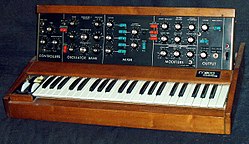Analog synthesizer
This article needs additional citations for verification. (April 2009) |

An analog synthesizer (
The earliest analog synthesizers in the 1920s and 1930s, such as the Trautonium, were built with a variety of vacuum-tube (thermionic valve) and electro-mechanical technologies. After the 1960s, analog synthesizers were built using operational amplifier (op-amp) integrated circuits, and used potentiometers (pots, or variable resistors) to adjust the sound parameters. Analog synthesizers also use low-pass filters and high-pass filters to modify the sound. While 1960s-era analog synthesizers such as the Moog used a number of independent electronic modules connected by patch cables, later analog synthesizers such as the Minimoog integrated them into single units, eliminating patch cords in favour of integrated signal routing systems.
History
1900–1920
The earliest mention of a "synthetic harmoniser" using electricity appears to be in 1906, created by the Scottish physicist
1920s–1950s

The earliest synthesizers used a variety of thermionic-valve (
1960s–1970s
Early analog synthesizers used technology from electronic analog computers and laboratory test equipment. They were generally "modular" synthesizers, consisting of a number of independent electronic modules connected by patch cables into a
Famous

Notable makers of all-in-one analog synthesizers included Moog, ARP,

In 1978, the first
1980s–present
During the middle to late 1980s,
Over time, this increased demand for used units (such as the 1980
More recently, the resurgence has been supported by analog modeling synthesizers, new analog hardware from companies like Moog, Korg, and Behringer, and the booming Eurorack modular format, which reintroduced the appeal of customizable modular synthesis to a new generation of users.
Use in modern music
The lapse of patents in recent years, such as for the
Another factor contributing to the resurgence of analog synthesizers is a renewed appreciation for the hands-on, tactile experience they provide. Unlike digital software synthesizers, which rely on screen-based interfaces, analog synths allow musicians to physically manipulate knobs, faders, and patch cables, enabling real-time interaction and creative experimentation. This direct control over sound-shaping has led many producers and performers to integrate analog synthesizers into their workflow.[5]
The revival of analog technology has also been fueled by a wave of reissues and recreations of classic synthesizers by major manufacturers. Companies such as Moog, Roland, and Korg have reintroduced vintage models, while new analog synths continue to be developed, bringing analog synthesis to a new generation of musicians. Some of the most iconic synthesizers of past decades have been digitally recorded and made available as sample packs for use in computer-based music production, further highlighting their enduring influence.[6]
Hybrid approaches to music production have also gained popularity, with artists combining analog hardware with digital audio workstations (DAWs) to achieve the warmth and depth of analog sound while maintaining the flexibility of modern digital tools. The distinct sonic character of analog synthesizers remains a defining feature of many electronic and pop music productions, as well as film scores and experimental compositions.[7]
See also
References
- ^ Proceedings of the Royal Society of Edinburgh 1906
- ^ 1957 Evgeny Murzin ANS synthesizer, Kom. Musik, September 6, 2006, retrieved 15 February 2006
- ^ 1970 Robert Moog Moog Music Minimoog Synthesizer, Mix Magazine, September 1, 2006, archived from the original on 28 March 2008, retrieved 10 April 2008
- ^ Kirn, Peter (2013-07-29). "Video Explains Why Difference Between Analog, Digital Isn't What Most People Think". Create Digital Media, GmbH. Retrieved 2015-05-24.
- ISBN 978-0-674-04216-2.
- ISBN 978-0-08-052208-1, retrieved 2025-04-26
- ^ RCA Electronic Music Synthesizer. Oxford Music Online. Oxford University Press. 2001.
External links
- ARP synthesizer patents
- Modular Analog Synthesizers Return! – a discussion of modern modular equipment with links to major manufacturers.
